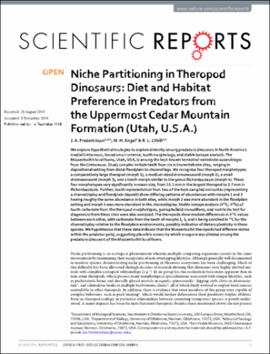| dc.contributor.author | Frederickson, J. A. | |
| dc.contributor.author | Engel, M. H. | |
| dc.contributor.author | Cifelli, R. L. | |
| dc.date.accessioned | 2019-04-02T18:56:40Z | |
| dc.date.available | 2019-04-02T18:56:40Z | |
| dc.date.issued | 2018-12-14 | |
| dc.identifier.citation | Frederickson, J. A. Engel, M. H. Cifelli, R. L. (2018). Niche Partitioning in Theropod Dinosaurs: Diet and Habitat Preference in Predators from the Uppermost Cedar Mountain Formation (Utah, U.S.A.). Scientific reports, 8(17872). | en_US |
| dc.identifier.uri | https://hdl.handle.net/11244/317833 | |
| dc.description.abstract | We explore hypothetical ecologies to explain diversity among predatory dinosaurs in North America’s medial Cretaceous, based on occurrence, tooth morphology, and stable isotope analysis. The Mussentuchit local fauna, Utah, USA, is among the best-known terrestrial vertebrate assemblages from the Cretaceous. Study samples include teeth from six microvertebrate sites, ranging in depositional setting from distal floodplain to channel lags. We recognize four theropod morphotypes: a comparatively large theropod (morph 1), a medium-sized dromaeosaurid (morph 2), a small dromaeosaurid (morph 3), and a tooth-morph similar to the genus Richardoestesia (morph 4). These four morphotypes vary significantly in mean size, from 15.1 mm in the largest theropod to 3.7 mm in Richardoestesia. Further, tooth representation from two of the best-sampled microsites (representing a channel/splay and floodplain deposit) show differing patterns of abundances with morphs 1 and 3 having roughly the same abundance in both sites, while morph 2 was more abundant in the floodplain setting and morph 4 was more abundant in the channel/splay. Stable isotope analysis (δ13C; δ18O) of tooth carbonate from the theropod morphotypes, goniopholidid crocodilians, and matrix (to test for diagenesis) from these sites were also analyzed. The theropods show modest differences in δ13C values between each other, with carbonate from the teeth of morphs 1, 3, and 4 being enriched in 13C for the channel/splay relative to the floodplain environments, possibly indicative of dietary plasticity in these species. We hypothesize that these data indicate that the Mussentuchit theropods had different niches within the predator guild, suggesting plausible means by which ecospace was divided among the predatory dinosaurs of the Mussentuchit local fauna. | en_US |
| dc.description.sponsorship | The authors thank Steve Westrop and Roger Burkhalter for photographic assistance and Brent Tweedy for his help prepping samples for isotopic analysis and analytical assistance. Partial funding for this project was provided by the Jurassic Foundation. Specimens were collected under the auspices of grants from the National Geographic Society (4761-91 and 5021-92) and National Science Foundation (BSR-8906992, DEB-9401094, DEB-9870173) to RLC.
Open access fees fees for this article provided whole or in part by OU Libraries Open Access Fund. | en_US |
| dc.language | en_US | en_US |
| dc.rights | Attribution 4.0 International | * |
| dc.rights.uri | https://creativecommons.org/licenses/by/4.0/ | * |
| dc.subject | Palaeontology | en_US |
| dc.subject | Palaeoecology | en_US |
| dc.title | Niche Partitioning in Theropod Dinosaurs: Diet and Habitat Preference in Predators from the Uppermost Cedar Mountain Formation (Utah, U.S.A.) | en_US |
| dc.type | Article | en_US |
| dc.description.peerreview | Yes | en_US |
| dc.identifier.doi | 10.1038/s41598-018-35689-6 | en_US |
| ou.group | College of Arts and Sciences::Department of Biology | en_US |

